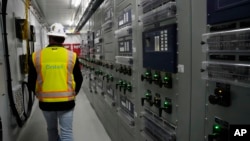In the Arizona desert, a Danish company is building a massive solar farm that will include batteries that charge when the sun shines and provide power to the grid when the sun shines.
Combining batteries with green energy is a rapidly growing climate solution.
“Solar plants only generate electricity when the sun shines, and turbines only generate electricity when the wind blows,” said Mads Nipper, CEO of Ørsted. “To maximize the availability of green energy (24/7), we also have to store some energy.”
The United States is rapidly adding batteries, primarily lithium-ion, to store energy on a large scale. These projects are increasingly being combined with solar and wind projects, such as in Arizona. Agencies that run the grid, utilities and renewable energy developers say the combination of technologies is critical to a green energy future.
Batteries could allow renewable energy to replace fossil fuels such as oil, natural gas and coal, while maintaining a steady supply of electricity when energy sources such as wind and solar are out of service. For example, when people sleep, less electricity is used, and energy generated by nighttime winds can be stored in batteries and used during the day when demand is higher.
Tempe, Arizona, resident Juan Mendez gets his power from local utility Salt River Projects, which is building the Eleven Mile Solar Center in partnership with Ørsted. As a state senator, Mendez pushed SRP to shift toward renewable energy.
He believes the utility is still investing too much in natural gas and coal-fired power plants, including plans for a massive expansion of a natural gas plant in Coolidge, Arizona, near a solar center.
“Solar plus storage is a good move, but SRP needs to do more to provide clean energy, clean the air and help combat climate change,” Mendez said.
The utility says it will add more renewable energy to its energy mix and recently committed to achieving zero emissions by 2050.
The United States has the second largest electricity storage capacity in the world, after China. According to a fact sheet by Bloomberg New Energy Finance and the Sustainable Energy Business Council, the United States is expected to add 7.5 GW of new installed capacity in 2023, an increase of 62% from 2022.
According to Bloomberg New Energy Finance, this amount of electricity can provide electricity for 750,000 households for a day, making the country’s total installed capacity almost enough to meet the needs of 2 million households for a day.
In the United States, California leads the way in energy storage as it aggressively reduces greenhouse gas emissions. It has twice as many as other states. In just four years, residential, commercial and utility-scale battery installations have increased 757%, meaning there is now enough to power 6.6 million homes for up to four hours, according to the California Energy Commission.
Part of the reason is that in 2013, the California Public Utilities Commission required utilities to purchase energy storage units with a goal of doing so by 2020. Since then, power companies have continued to add batteries to help the state meet clean power requirements.
Southern California Edison is one utility adding thousands of hours of energy storage. It is putting in solar plus batteries to replace some power plants that burn natural gas and typically provide power at night.
“If it’s just clean and not reliable, you really have nothing,” said William Walsh, vice president for energy procurement and management. “We need both.”
In California, batteries proved their worth in September 2022, when the West was experiencing a prolonged heat wave with temperatures reaching triple digits.
On September 6, 2022, electricity demand reached an all-time high in the state as people turned on their air conditioners.
Walsh believes batteries added to the grid between 2020 and 2022 will help avoid blackouts. Two years ago, California experienced rolling blackouts during a similar heat wave.
Texas has the second-largest battery storage capacity after California. Last month, Schneider Electric announced a partnership with energy company ENGIE North America to develop solar and battery systems in Texas, furthering the French multinational’s goal of 100% renewable energy in the United States and Canada. Hans Royal, senior director of renewable energy and carbon consulting at Schneider Electric, said the deal and the necessary $80 million investment are not possible until the passage of a major climate law, the Inflation Reduction Act, in 2022 of.
Royal is advising other global Fortune 500 companies it works with on entering this market.
“The industry needs it and the grid needs it,” Royal said.
Back in Arizona, Ørsted’s Eleven Mile Solar Center is located on 2,000 acres in rural Pinal County. It has 857,000 solar panels and more than 2,000 cubes, which look like large shipping containers but contain battery modules. Ørsted also has large solar and storage projects in Texas, Alabama and Europe.
When the Arizona facility opens this summer, much of the solar farm’s power will be delivered to Facebook owner Meta’s data center in Mesa. In addition to the electricity stored in the batteries, the solar energy Meta does not need will be provided to local utility customers. The new batteries will ensure power is available for approximately 65,000 homes during peak demand periods.
“I think what’s exciting is how quickly this market is evolving,” said Yayoi Sekine, head of energy storage at Bloomberg New Energy Finance. “The U.S. and different regions are under tremendous pressure to decarbonize, and energy storage is a major part of how to do that. One of the technologies. There’s a lot of momentum.”
Follow us on Google news ,Twitter , and Join Whatsapp Group of thelocalreport.in


















